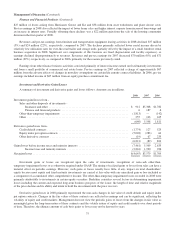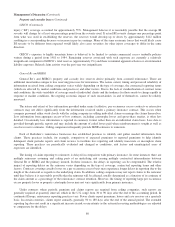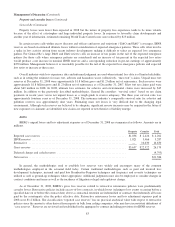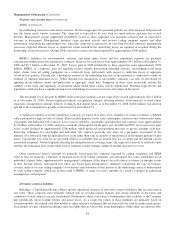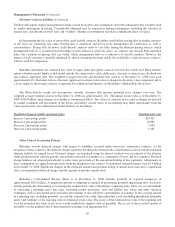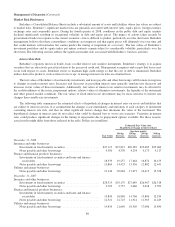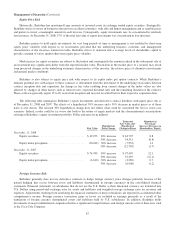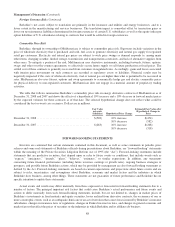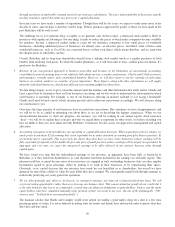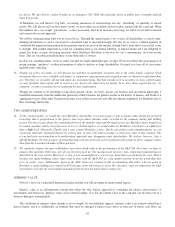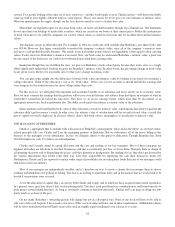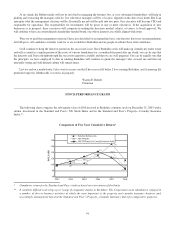Berkshire Hathaway 2008 Annual Report Download - page 86
Download and view the complete annual report
Please find page 86 of the 2008 Berkshire Hathaway annual report below. You can navigate through the pages in the report by either clicking on the pages listed below, or by using the keyword search tool below to find specific information within the annual report.Management’s Discussion (Continued)
Property and casualty losses (Continued)
BHRG (Continued)
In establishing retroactive reinsurance reserves, historical aggregate loss payment patterns are often analyzed and projected
into the future under various scenarios. The claim-tail is expected to be very long for many policies and may last several
decades. Management assigns judgmental probability factors to these aggregate loss payment scenarios and an expectancy
outcome is determined. Management monitors claim payment activity and reviews ceding company reports and other
information concerning the underlying losses. Since the claim-tail is expected to be very long for such contracts, management
reassesses expected ultimate losses as significant events related to the underlying losses are reported or revealed during the
monitoring and review process. During 2008, retroactive reserves developed upward by approximately $200 million.
BHRG’s liabilities for environmental, asbestos, and latent injury losses and loss adjustment expenses are presently
concentrated within retroactive reinsurance contracts. Reserves for such losses were approximately $9.2 billion at December 31,
2008 and $9.7 billion at December 31, 2007. Losses paid in 2008 attributable to these exposures were approximately $700
million. BHRG, as a reinsurer, does not regularly receive reliable information regarding asbestos, environmental and latent
injury claims from all ceding companies on a consistent basis, particularly with respect to multi-line treaty or aggregate
excess-of-loss policies. Periodically, a ground-up analysis of the underlying loss data of the reinsured is conducted to make an
estimate of ultimate reinsured losses. When detailed loss information is unavailable, estimates can only be developed by
applying recent industry trends and projections to aggregate client data. Judgments in these areas necessarily include the
stability of the legal and regulatory environment under which these claims will be adjudicated. Potential legal reform and
legislation could also have a significant impact on establishing loss reserves for mass tort claims in the future.
The maximum losses payable by BHRG under retroactive policies are not expected to exceed approximately $24.3 billion
as of December 31, 2008. Absent significant judicial or legislative changes affecting asbestos, environmental or latent injury
exposures, management currently believes it unlikely that unpaid losses as of December 31, 2008 ($16.6 billion) will develop
upward to the maximum loss payable or downward by more than 15%.
A significant number of recent reinsurance contracts are expected to have a low frequency of claim occurrence combined
with a potential for high severity of claims. These include property losses from catastrophes, terrorism and aviation risks under
catastrophe and individual risk contracts. Loss reserves related to catastrophe and individual risk contracts were approximately
$1.3 billion at December 31, 2008, and were essentially unchanged from the prior year. In 2008 and 2007, loss reserves for prior
years’ events declined by approximately $200 million which produced corresponding increases to pre-tax earnings each year.
Reserving techniques for catastrophe and individual risk contracts generally rely more on a per-policy assessment of the
ultimate cost associated with the individual loss event rather than with an analysis of the historical development patterns of past
losses. Catastrophe loss reserves are provided when it is probable that an insured loss has occurred and the amount can be
reasonably estimated. Absent litigation affecting the interpretation of coverage terms, the expected claim-tail is relatively short
and thus the estimation error in the initial reserve estimates usually emerges within 24 months after the loss event.
Other reinsurance reserve amounts are generally based upon loss estimates reported by ceding companies and IBNR
reserves that are primarily a function of reported losses from ceding companies and anticipated loss ratios established on an
individual contract basis, supplemented by management’s judgment of the impact on each contract of major catastrophe events
as they become known. Anticipated loss ratios are based upon management’s judgment considering the type of business
covered, analysis of each ceding company’s loss history and evaluation of that portion of the underlying contracts underwritten
by each ceding company, which are in turn ceded to BHRG. A range of reserve amounts as a result of changes in underlying
assumptions is not prepared.
Derivative contract liabilities
Berkshire’s Consolidated Balance Sheets include significant amounts of derivative contract liabilities that are measured at
fair value. These contracts were primarily entered into in over-the-counter markets and certain elements in the terms and
conditions of such contracts are not standardized. Furthermore, there is no source of independent data available to the Company
that periodically shows trading volume and actual prices. As a result, the values of these liabilities are primarily based on
valuation models, discounted cash flow models or other valuation techniques that are believed to be used by market participants.
Such models or other valuation techniques may use inputs that are observable in the marketplace, while others are unobservable.
84



